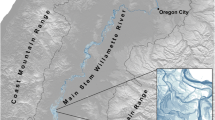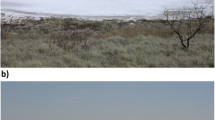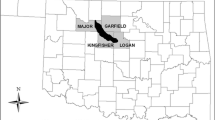Abstract
Remote sensing imagery can be an invaluable resource to quantify land change in coastal wetlands. Obtaining an accurate measure of land change can, however, be complicated by differences in fluvial and tidal inundation experienced when the imagery is captured. This study classified Landsat imagery from two wetland areas in coastal Louisiana from 1983 to 2010 into categories of land and water. Tide height, river level, and date were used as independent variables in a multiple regression model to predict land area in the Wax Lake Delta (WLD) and compare those estimates with an adjacent marsh area lacking direct fluvial inputs. Coefficients of determination from regressions using both measures of water level along with date as predictor variables of land extent in the WLD, were higher than those obtained using the current methodology which only uses date to predict land change. Land change trend estimates were also improved when the data were divided by time period. Water level corrected land gain in the WLD from 1983 to 2010 was 1 km2 year−1, while rates in the adjacent marsh remained roughly constant. This approach of isolating environmental variability due to changing water levels improves estimates of actual land change in a dynamic system, so that other processes that may control delta development such as hurricanes, floods, and sediment delivery, may be further investigated.








Similar content being viewed by others
References
Barras, J. 2006. USGS Open File Report 2006–1274: Land area changes in coastal Louisiana after the 2005 hurricanes: a series of three maps. U.S. Geological Survey publication. http://pubs.usgs.gov/of/2006/1274/. Accessed 7 December 2009.
Barras, J. A. 2007. USGS Data Series 281: Satellite images and aerial photographs of the effects of Hurricanes Katrina and Rita on coastal Louisiana. U.S. Geological Survey Publication. http://pubs.usgs.gov/ds/2007/281/. Accessed 7 December 2009.
Barras, J. A. 2009. USGS Scientific Investigations Map 3080: Land area change and overview of major hurricane impacts in coastal Louisiana, 2004–08. U.S. Geological Survey Publication. http://pubs.usgs.gov/sim/3080/. Accessed 7 December 2009.
Barras, J., S. Beville, D. Britsch, S. Hartley, S. Hawes, J. Johnston, P. Kemp, Q. Kinler, A. Martucci, J. Porthouse, D. Reed, K. Roy, S. Sapkota, and J. Suhayda. 2003. Historical and projected coastal Louisiana land changes—1978–2050: U.S. Geological Survey Open-File Report 2003–334, 39 p.
Barras, J., J. Bernier, and R. Morton. 2008. USGS Scientific Investigations Map 3019, Land area change in coastal Louisiana: A multidecadal perspective (from 1956 to 2006). U.S. Geological Survey Publication. http://pubs.usgs.gov/sim/3019/. Accessed 7 December 2009.
Cahoon, D. 2006. A review of major storm impacts on coastal wetland elevations. Estuaries and Coasts 29: 889–898. doi:10.1007/BF02798648.
Calzadilla Pérez, A., M.C.J. Damen, D. Geneletti, and T.W. Hobma. 2002. T1—monitoring a recent delta formation in a tropical coastal wetland using remote sensing and GIS. Case Study: Guapo River Delta, Laguna de Tacarigua, Venezuela. Environment, Development and Sustainability 2: 201–219. doi:10.1023/A:1020830809448.
Chander, G., and B. Markham. 2003. Revised Landsat-5 TM radiometric calibration procedures and postcalibration dynamic ranges. IEEE Transactions on Geoscience and Remote Sensing, 41: 2674–2677. http://landsat.usgs.gov/documents/L5_TM_Cal_2003.pdf. Accessed 9 Aug 2010.
Chander, G., B.L. Markham, and J.A. Barsi. 2007. Revised Landsat-5 Thematic Mapper radiometric calibration. IEEE Geoscience and Remote Sensing Letters 4: 490–494. http://landsat.usgs.gov/documents/L5TM_postcal.pdf. Accessed 9 Aug 2010.
Chen, L.C. 1998. Detection of shoreline changes for tideland areas using multi-temporal satellite images. International Journal of Remote Sensing 19: 3383. doi:10.1080/014311698214055.
Chen, W., and H. Chang. 2009. Estimation of shoreline position and change from satellite images considering tidal variation. Estuarine, Coastal and Shelf Science 84: 54–60. doi:10.1016/j.ecss.2009.06.002.
Day, J.W., L.D. Britsch, S.R. Hawes, G.P. Shaffer, D.J. Reed, and D. Cahoon. 2000. Pattern and process of land loss in the Mississippi Delta: a spatial and temporal analysis of wetland habitat change. Estuaries 23: 425. doi:10.2307/1353136.
Fitzegerald, S. M. 1998. Sand body geometry of the Wax Lake Outlet Delta Atchafalaya Bay, Louisiana. PhD dissertation. Department of Oceanography and Coastal Sciences, Louisiana State University, 130 p.
Frazier, P.S., and K.J. Page. 2000. Water body detection and delineation with Landsat TM data. Photogrammetric Engineering and Remote Sensing. 66: 1461–1467.
Haack, B. 1996. Monitoring wetland changes with remote sensing: an East African example. Environmental Management 20: 411–419. doi:10.1007/BF01203848.
Howes, N.C., D.M. FitzGerald, Z.J. Hughes, I.Y. Georgiou, M.A. Kulp, M.D. Miner, J.M. Smith, and J.A. Barras. 2010. Hurricane-induced failure of low salinity wetlands. Proceedings of the National Academy of Sciences 107: 14014–14019. doi:10.1073/pnas.0914582107.
Kim, W., D. Mohrig, R. Twilley, C. Paola, and G. Parker. 2009. Is it feasible to build new land in the Mississippi River Delta? Eos, Transactions American Geophysical Union 90: 373. doi:10.1029/2009EO420001.
Lu, D., P. Mausel, E. Brondízio, and E. Moran. 2004. Change detection techniques. International Journal of Remote Sensing 25: 2365. doi:10.1080/0143116031000139863.
Mason, D.C., T.R. Scott, and S.L. Dance. 2010. Remote sensing of intertidal morphological change in Morecambe Bay, U.K., between 1991 and 2007. Estuarine, Coastal and Shelf Science 87: 487–496. doi:10.1016/j.ecss.2010.01.015.
McKee, K.L., and J.A. Cherry. 2009. Hurricane Katrina sediment slowed elevation loss in subsiding brackish marshes of the Mississippi River Delta. Wetlands 29: 2–15. doi:10.1672/08-32.1.
Ozesmi, S.L., and M.E. Bauer. 2002. Satellite remote sensing of wetlands. Wetlands Ecology and Management 10: 381–402.
Roberts, H. 1980. Evolution of sand-dominant subaerial phase, Atchafalaya Delta, Louisiana. The American Association of Petroleum Geologists Bulletin 64: 264–279.
Roberts, H., N. Walker, R. Cunningham, G. Kemp, and S. Majersky. 1997. Evolution of sedimentary architecture and surface morphology: Atchafalaya and Wax Lake Deltas, Louisiana (1973–1994). Gulf Coast Association of Geological Societies Transactions 47: 477–484.
Roberts, H.H., J.M. Coleman, S.J. Bentley, and N. Walker. 2003. An embryonic major delta lobe: a new generation of delta studies in the Atchafalaya–Wax Lake delta system. Gulf Coast Association of Geological Societies Transactions 53: 690–703.
Rouse, L.J., H.H. Roberts, and R.H.W. Cunningham. 1978. Satellite observation of the subaerial growth of the Atchafalaya Delta, Louisiana. Geology 6: 405–408. doi:10.1130/0091-7613(1978).
Ryu, J., J. Won, and K.D. Min. 2002. Waterline extraction from Landsat TM data in a tidal flat: a case study in Gomso Bay, Korea. Remote Sensing of Environment 83: 442–456. doi:10.1016/S0034-4257(02)00059-7.
Ryu, J., C. Kim, Y. Lee, J. Won, S. Chun, and S. Lee. 2008. Detecting the intertidal morphologic change using satellite data. Estuarine, Coastal and Shelf Science 78: 623–632. doi:10.1016/j.ecss.2008.01.020.
Sea Levels Online. 2009. NOAA Grand Isle Gage 8761724. National Oceanic and Atmospheric Administration. http://tidesandcurrents.noaa.gov/sltrends/sltrends_station.shtml?stnid=8761724%20Grand%20Isle,%20LA. Accessed 7 December 2009.
Shlemon, R. 1973. Atchafalaya Bay, Louisiana: regional subsidence and contemporary delta formation. Gulf Coast Association of Geological Societies Transactions 23: 22–26.
Souza Filho, P.W.M., E.D.S. Farias Martins, and F.R. da Costa. 2006. Using mangroves as a geological indicator of coastal changes in the Bragança macrotidal flat, Brazilian Amazon: a remote sensing data approach. Ocean & Coastal Management 49: 462–475. doi:10.1016/j.ocecoaman.2006.04.005.
Syvitski, J.P., and Y. Saito. 2007. Morphodynamics of deltas under the influence of humans. Global and Planetary Change 57: 261–282. doi:10.1016/j.gloplacha.2006.12.001.
Turner, R.E., J.J. Baustian, E.M. Swenson, and J.S. Spicer. 2006. Wetland sedimentation from Hurricanes Katrina and Rita. Science 314: 449–452. doi:10.1126/science.1129116.
Tye, R.S., and J.M. Coleman. 1989. Depositional processes and stratigraphy of fluvially dominated lacustrine deltas: Mississippi Delta Plain. Journal of Sedimentary Petrology 59: 973–996.
U.S. Army Corps of Engineers. 2009. Stage data—Lower Atchafalaya River at Morgan City, LA - Station 03780. http://www.mvn.usace.army.mil/cgi-bin/watercontrol.pl?03780. Accessed 7 December 2009.
U.S. Department of Agriculture. 2009. Aerial Photography Field Office. National Agricultural Inventory Project. http://www.apfo.usda.gov. Accessed 30 Dec 2010.
U.S. Geological Survey. 2009. National water information system: web interface. http://waterdata.usgs.gov/nwis/nwisman/?site_no=07381490&agency_cd=USGS. Accessed 17 Jul 2009.
vanHeerden, I., and H.H. Roberts. 1980. The Atchafalaya Delta—Louisiana's new prograding coast. Gulf Coast Association of Geological Societies Transactions 30: 497–506.
Yue, T.X., J.Y. Liu, S.E. Jørgensen, and Q.H. Ye. 2003. Landscape change detection of the newly created wetland in Yellow River Delta. Ecological Modelling 164: 21–31. doi:10.1016/S0304-3800(02)00391-5.
Zhao, B., H. Guo, Y. Yan, Q. Wang, and B. Li. 2008. A simple waterline approach for tidelands using multi-temporal satellite images: a case study in the Yangtze Delta. Estuarine, Coastal and Shelf Science 77: 134–142. doi:10.1016/j.ecss.2007.09.022.
Acknowledgments
Continuing support during this analysis was provided by the US Army Corps of Engineers, New Orleans District Office, and the US Army Corps of Engineers Engineer Research and Development Center. Thoughtful reviews by Greg Steyer (US Geological Survey), Guerry Holm (Louisiana State University), Sally Yost, and Molly Reif (both of US Army Corps of Engineers) greatly improved an earlier version of this manuscript.
Author information
Authors and Affiliations
Corresponding author
Rights and permissions
About this article
Cite this article
Allen, Y.C., Couvillion, B.R. & Barras, J.A. Using Multitemporal Remote Sensing Imagery and Inundation Measures to Improve Land Change Estimates in Coastal Wetlands. Estuaries and Coasts 35, 190–200 (2012). https://doi.org/10.1007/s12237-011-9437-z
Received:
Revised:
Accepted:
Published:
Issue Date:
DOI: https://doi.org/10.1007/s12237-011-9437-z




